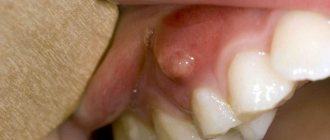Tooth extraction is a type of surgical intervention. The consequences of this operation may vary. Many people worry about the resulting wound. How long does it take for the affected area to heal, when will the bleeding stop and how often is ichor released after tooth extraction are some of the most exciting questions for patients. To prevent the development of complications, it is necessary to properly care for the resulting wound.
Sukrovitsa - f. Yellowish fluid that flows along with blood from the affected areas of the body, as well as bloody fluid that flows from abscesses and ulcers. Modern explanatory dictionary of the Russian language by Efremova
To prevent the development of complications after tooth extraction, it is necessary to properly care for the resulting wound.
Characteristic symptoms after tooth extraction (extraction)
During the process of tooth extraction, inevitable damage occurs to soft tissues, blood vessels, mucous membranes, nerve endings and other matters involved in holding the tooth. At the end of the operation, a natural inflammatory process develops, which is accompanied by various symptoms. Among which stand out:
- bleeding, the duration depends on various factors, can last from thirty minutes to three hours after tooth extraction;
- pain at the site of tooth extraction, which may be accompanied by pain in nearby teeth and even organs;
- swelling of the affected area;
- clearly defined redness of the mucous membrane at the site of the excluded tooth;
- possible increase in temperature;
- discomfort when moving the jaw.
The above signs are considered normal manifestations after tooth extraction. The inflammatory process decreases as the affected area is restored. As a rule, this takes from four to seven days . If an infection enters the body, the wound healing process is delayed and it is necessary to take medications.
In the place of the excluded tooth, a hole is formed that has sufficient depth, which is due to the long root system of the tooth. After bleeding stops from the site of tooth extraction, a blood clot forms, which promotes wound healing and prevents harmful bacteria from entering. If bleeding continues from the formed hole after tooth extraction for more than three hours, you must contact your doctor to take the required measures. This may include prescribing special medications, suturing the affected area, or using a hemostatic sponge.
Signs of inflammation
The inflammatory process in the socket occurs when a blood clot is damaged and the wound becomes infected. The following signs indicate its development:
- pain of varying intensity - aching, throbbing,
- fatigue and severe weakness,
- rise in temperature to subfebrile levels,
- unpleasant odor and taste in the mouth,
- pain when touched, contact with hot and cold,
- discharge of pus,
- difficulty chewing, swallowing, opening the mouth.
With alveolitis, the socket may become dry and a greenish or yellowish coating may form. If a blood clot falls out and pain occurs, do not put off visiting the dentist. It is easier to stop the inflammatory process at its beginning. The doctor will curettage the hole, treat the wound with an antiseptic solution, and prescribe antibacterial drugs.
Causes of ichor after tooth extraction
Associated factors influencing the duration of ichor discharge after tooth extraction:
- damage to blood vessels;
- inflammatory reaction in damaged tissues;
- hypertensive crisis;
- poor blood clotting indicators.
When a patient has hypertension, the risk of severe bleeding from the site of the extracted tooth increases. This is due to taking medications that lead to blood thinning. Experts recommend stopping taking such medications a couple of days before the planned surgery.
Also a dangerous factor is the presence of low blood clotting in the patient. In this case, it is recommended to take a course of sedatives to prevent surges in blood pressure.
How long does it take for a dry socket to heal?
Many people are interested in the question of how long it takes for a dry socket to heal. In the absence of complications, the wound heals in 5 - 7 days, and within a month the hole is filled with epithelial tissue. If you have dry socket, the healing process may take longer than two weeks (with proper treatment, of course). As already mentioned, extensive inflammation may occur and even require surgical hospitalization of the patient: in this case, the healing of the dry socket may be very delayed.
Caring for the socket of an extracted tooth
After tooth extraction, to prevent the development of complications and reduce the secreted ichor, as well as to speed up the healing of the wound, it is necessary to properly care for the resulting hole. To do this, you should adhere to the following recommendations:
- Hold the tampon with the medicinal substance applied by the dentist for thirty minutes;
- If a blood clot forms in the socket, it is not recommended to rinse it, spit it out, or remove it by other methods during the day;
- Do not disturb the damaged area by palpating with your tongue or other means;
- Do not chew food with the place where the tooth was removed, and do not suck any drinks through a straw for 24 hours;
- Limit or completely eliminate heavy physical activity;
- Avoid visiting bathhouses, saunas, taking hot showers and prolonged exposure to sunlight for a day;
- The use of warming compresses in the area of tooth extraction is prohibited;
- For three hours after surgery, you must stop eating;
- To avoid the development of swelling and pain, it is necessary to eat only warm foods and drinks for several days;
- Eliminate hot, spicy additives, as well as foods with sour and strong tastes for a couple of days. Such dishes can contribute to the opening of re-bleeding;
- If food particles get into the hole with a clot, you must rinse your mouth until they are completely removed. In this case, it is strictly forbidden to use a toothpick, fingers or other methods to clean the socket, since it is possible to disrupt the formed blood clot;
- Eliminate the use of alcohol and tobacco products for a period of three to seven days;
- After 24 hours after the operation, it is necessary to rinse the mouth with a soda solution or special antiseptic agents;
- When cleaning tooth enamel, it is necessary to perform this operation extremely carefully in the area of the extracted tooth;
What can and cannot be done after tooth extraction?
In case of individual intolerance to pain after tooth extraction, it is permissible to use medications against pain, which belong to the group of non-steroidal anti-inflammatory drugs. When performing surgery against the background of infectious diseases in the oral cavity, for further recovery it is necessary to take a course of antibiotics.
After the removal of a wisdom tooth, you must adhere to the same recommendations, the only difference is that the symptoms are more severe.
The main functions performed by such a “thrombus”
If a clot has formed at the site of the extracted tooth, then this is a good sign. It is this that protects a fresh wound from the aggressive environment of the oral cavity, where a large number of bacteria live. It also prevents saliva and food debris from entering injured tissues, protects them from the inflammatory process and related complications (alveolitis, abscess, gumboil, phlegmon, osteomyelitis).
The clot promotes the natural healing process of areas damaged during surgery. Moreover, some researchers claim that it even accelerates the process of tissue regeneration, and if it is not formed or falls out ahead of time, the rehabilitation period lasts longer.
Ways to stop ichor after tooth extraction
After tooth extraction, the dentist carries out a number of measures to stop bleeding:
- installation of a tampon impregnated with special medicinal substances;
- application of a hemostatic sponge;
- prescribing medications for better blood clotting;
- suturing the damaged area.
During normal tooth extraction, to stop bleeding, it is enough to use a tampon, which is held pressed for thirty minutes. If complications arise to stop bleeding, more radical measures are used in the form of suturing; this technique is used in case of damage to the artery. When small vessels are damaged, coagulation (cauterization of ruptured vessels) is most often used. After removing a wisdom tooth or several teeth located nearby, additional sutures are applied to prevent the development of complications.
If it is impossible to quickly determine the cause of bleeding, injections with substances are administered to stop the bleeding. Two methods are used for this:
- Intramuscular injection of Vikasol solution one percent;
- Intravenous injection of a solution of the following components: ten percent calcium chloride solution, calcium gluconate.
If bleeding occurs at home, you need to prepare a small tampon or sterile bandage. Place on the damaged area, after thoroughly washing your hands, and eat for a period of forty minutes. If this method does not help stop the ichor, it is necessary to prepare a new tampon, which must be moistened with a three percent solution of hydrogen peroxide. This solution has a clotting effect on the blood. Apply the tampon for five to ten minutes.
If the bleeding cannot be stopped, you should consult a doctor as soon as possible.
In what cases should you seek medical help?
You should seek dental help after removing a figure eight in the following cases:
- with constant bleeding, the abundance of which does not decrease;
- with dizziness, severe headache and weakness;
- with sharp and severe pain in the gum area;
- with bloody discharge mixed with pus;
- when the elevated temperature persists for several days.
Swelling and swelling after the procedure are not a cause for concern. But when such swelling does not go away, then for your own safety it is better to visit the clinic as soon as possible.
Receiving technology
The technology for manufacturing the drug is available and consists of the following steps:
- Blood is drawn from the Patient's vein (for the A-PRF form only glass tubes are used, for PRE - plastic), the quantity and volumes are determined by the doctor depending on the purpose;
- within fifteen minutes the blood is processed in a centrifuge, where fractions are separated and protein is separated;
- after turning off the equipment, you need to wait for the formation of a clot, which is removed with tweezers and placed in the box;
- By removing excess liquid, the specialist receives a membrane, which is given the desired shape and size with scissors.
Scope of application
Enriched fibrin is officially recognized as a drug with an effective effect in healing and regeneration after surgery. One of the areas where the drug is used most actively is dentistry. Membranes show excellent results in implantation, treatment of soft tissues, and bone restoration.
Areas of use:
- in case of complex tooth extraction, if there is a need to preserve bone volume, alveolar walls, and prevent complications;
- to prevent gum recession (the drug is applied to the exposed necks, preventing further deterioration);
- to perform preimplantation augmentation, including in case of hard tissue deficiency;
- as a coating for artificial roots during implantation (used to accelerate the integration of the implant into the bone);
- during closed or open sinus lifting;
- for immediate implantation, to stabilize the rod after screwing in;
- performing patchwork surgical interventions, including recession of gum tissue, sinus lifting, elimination of various types of defects, wound therapy;
- rapid healing during maxillofacial plastic surgery, prevention of complications.
What can you do at home?
If the problem has not resolved itself within three hours, then the following tips will help you:
- Apply a cold compress to your cheek. You can use a cold product or ice previously wrapped in cloth.
- Roll up sterile gauze, apply to the hole and bite for 10-15 minutes.
- Make strong tea. Soak a piece of bandage in liquid and apply to the damaged mucous membrane for 3-5 minutes.
- If you experience high blood pressure, you need to normalize it with medication. The specific drug and dosage are prescribed by the doctor.
Types of pathology
Today, it is customary to distinguish several types of pathological bleeding: early and late, otherwise they are called primary and secondary. In the first case, we are talking about the fact that the blood does not stop for a long time immediately after the extraction of the diseased unit from the series. If the bleeding stopped quickly in the clinic, but started again at home, then secondary bleeding is occurring, and its causes should be investigated.
It is important to understand that during tooth extraction the surgeon applies quite a lot of force, which can damage blood vessels and unaffected soft tissues. This is why the appearance of blood is absolutely normal.
Only the dynamics of the development of the situation in the future and the patient’s well-being can indicate the beginning of the pathological process. To avoid complications, you should adhere to certain recommendations of a specialist, maintain oral hygiene and not injure the just operated area.









